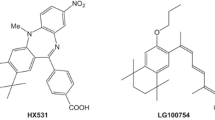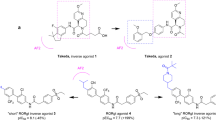Abstract
Cellular retinol binding proteins (CRBPs) are industrially important lipocalin proteins which can be potential targets for drug development, scaffold engineering, and biosensor development. The introduction of Q108R site-directed mutagenesis in this protein changes the ligand-binding specificities, but its structural effect is still unclear. In this study, the ligand-binding modes of CRBP and its Q108R mutant were studied by molecular docking approach. The specific interaction between the terminal functional groups of retinoids and 108th residue of the protein was determined to be conserved in the ligand-binding complexes, but the interaction patterns of non-binding complexes were identified to be significantly different from those of binding complexes. These results suggest that the specific interaction between 108 Q or R residue of CRBP(I) and terminal functional group of retinoid may be crucial in the formation of stable ligand conformation in the binding site.
Similar content being viewed by others
References
Blomhoff, R. and H. K. Blomhoff (2006) Overview of retinoid metabolism and function. J. Neurobiol. 66: 606–630.
Noy, N. (2000) Retinoid-binding proteins: mediators of retinoid action. Biochem. J. 348: 481–495.
Blomhoff, R., M. H. Green, T. Berg, and K. R. Norum (1990) Transport and storage of vitamin A. Science. 250: 399–404.
Kono, N. and H. Arai (2015) Intracellular transport of fat-soluble vitamins A and E. Traffic. 16: 19–34.
Chytil, F. and D. E. Ong (1983) Cellular retinol- and retinoic acid-binding proteins. Adv. Nutr. Res. 5: 13–29.
Jones, T. A., T. Bergfors, J. Sedzik, and T. Unge (1988) The three-dimensional structure of P2 myelin protein. EMBO J. 7: 1597–1604.
Ishaque, A., T. Hofmann, and E. H. Eylar (1982) The complete amino acid sequence of the rabbit P2 protein. J. Biol. Chem. 257: 592–595.
Ong, D. E. (1984) A novel retinol-binding protein from rat. Purification and partial characterization. J. Biol. Chem. 259: 1476–1482.
Bashor, M. M., D. O. Toft, and F. Chytil (1973) In vitro binding of retinol to rat-tissue components. Proc Natl Acad Sci U S A. 70: 3483–3487.
Kawaguchi, R., J. Yu, M. Ter-stepanian, M. Zhong, G. Cheng, Q. Yuan, M. Jin, G. H. Travis, D. Ong, and H. Sun (2011) Receptor-mediated cellular uptake mechanism that couples to intracellular storage. ACS Chem. Biol. 6: 1041–1051.
Penzes, P. and J. L. Napoli (1999) Holo-cellular retinol-binding protein: Distinction of ligand-binding affinity from efficiency as substrate in retinal biosynthesis. Biochemistry. 38: 2088–2093.
Herr, F. M. and D. E. Ong (1992) Differential interaction of lecithin-retinol acyltransferase with cellular retinol binding proteins. Biochemistry. 31: 6748–6755.
Orlandi, A., A. Ferlosio, A. Ciucci, A. Francesconi, B. Lifschitz-Mercer, G. Gabbiani, L. G. Spagnoli, and B. Czernobilsky (2006) Cellular retinol binding protein-1 expression in endometrial hyperplasia and carcinoma: diagnostic and possible therapeutic implications. Mod. Pathol. 19: 797–803.
Napoli, J. L. (2017) Cellular retinoid binding-proteins, CRBP, CRABP, FABP5: Effects on retinoid metabolism, function and related diseases. Pharmacol. Ther. 173: 19–33.
Munussami, G., S. Sokalingam, J. R. Kim, and S. G. Lee (2018) In silico study on retinoid-binding modes in human RBP and ApoD lipocalins. Biotechnol. Bioprocess Eng. 23: 158–167.
Cowan, S. W., M. E. Newcomer, and T. A. Jones (1993) Crystallographic studies on a family of cellular lipophilic transport proteins: Refinement of P2 myelin protein and the structure determination and refinement of cellular retinol-binding protein in complex with All-trans-retinol. J. Mol. Biol. 230: 1225–1246.
Malpeli, G., M. Stoppini, M. C. Zapponi, C. Folli, and R. Berni (1995) Interactions with retinol and retinoids of bovine cellular retinol-binding protein. Eur. J. Biochem. 229: 486–493.
Franzoni, L., C. Lucke, C. Perez, D. Cavazzini, M. Rademacher, C. Ludwig, A. Spisni, G. L. Rossi, and H. Ruterjans (2002) Structure and backbone dynamics of apo- and holo-cellular retinol-binding protein in solution. J. Biol. Chem. 277: 21983–21997.
Silvaroli, J. A., J. M. Arne, S. Chelstowka, P. D. Kiser, S. Banerjee, and M. Golczak (2016) Ligand binding induces conformational changes in human cellular retinol-binding protein 1 (CRBP1) revealed by atomic resolution crystal structures. J. Biol. Chem. 291: 8528–8540.
Stump, D. G., R. S. Lloyd, and F. Chytil (1991) Site-directed mutagenesis of rat cellular retinol-binding protein. Alteration in binding specificity resulting from mutation of glutamine 108 to arginine. J. Biol. Chem. 266: 4622–4630.
Franzoni, L., D. Cavazzini, G. L. Rossi, and C. Lucke (2010) New insights on the protein-ligand interaction differences between the two primary cellular retinol carriers. J. Lipid Res. 51: 1332–1343.
Jakoby, M. G., K. R. Miller, J. J. Toner, A. Bauman, L. Cheng, E. Li, and D. P. Cistola (1992) Ligand-protein electrostatic interactions govern the specificity of retinol- and fatty acid-binding proteins. Biochemistry. 32: 872–878.
Sacchettini, J. C., J. I. Gordon, and L. Banaszak (1989) Crystal structure of rat intestinal fatty-acid-binding protein: Refinement and analysis of the Escherichia coli-derived protein with bound palmitate. J. Mol. Biol. 208: 327–339.
Morris, G. M., R. Huey, W. Lindstrom, M. F. Sanner, R. K. Belew, D. S. Goodsell, and A. J. Olson (2009) AutoDock4 and AutoDockTools4: Automated docking with selective receptor flexibility. J. Comput. Chem. 30: 2785–2791.
The PyMOL Molecular Graphics System, Version 2.0 Schrödinger, LLC.
Pettersen, E. F., T. D. Goddard, C. C. Huang, G. S. Couch, D. M. Greenblatt, E. C. Meng, and T. E. Ferrin (2004) UCSF Chimera — a visualization system for exploratory research and analysis. J. Comput. Chem. 25: 1605–1612.
BIOVIA, Dassault Systèmes, Discovery Studio Modeling Environment, Release 2017, San Diego: Dassault Systèmes.
Zhang, Y. R., Y. Q. Zhao, and J. F. Huang (2012) Retinoid-binding proteins: Similar protein architectures bind similar ligands via completely different ways. PLoS One. 7: e36772.
Porté, S., F. X. Ruiz, J. Giménez, I. Molist, S. Alvarez, M. Domínguez, R. Alvarez, A. R. de Lera, X. Parés, and J. Farrés (2013) Aldo-keto reductases in retinoid metabolism: Search for substrate specificity and inhibitor selectivity. Chem. Biol. Interact. 202: 186–194.
Merugu, R. and K. V. Singh (2018) Molecular docking of amitriptyline to ceruloplasmin, retinol-binding protein, and serum albumin. Asian J. Pharm. Clin. Res. 11: 169–175.
Sokalingam, S., G. Munussami, J. R. Kim, and S. G. Lee (2018) Validation on the molecular docking efficiency of lipocalin family of proteins. J. Ind. Eng. Chem. 67: 293–300.
Kim, J. Y., H. W. Yoo, P. G. Lee, S. G. Lee, J. H. Seo, and B. G. Kim (2019) In vivo protein evolution, next generation protein engineering strategy: from random approach to target-specific approach. Biotechnol. Bioprocess Eng. 24: 85–94.
Jebamani, P., S. Sokalingam, D. K. Sriramulu, S. T. Jung, and S. G. Lee (2020) Assessment of computational modeling of Fc-Fc receptor binding through protein-protein docking tool. Biotechnol. Bioprocess Eng. 25: 734–741.
Skerra, A. (2000) Lipocalins as a scaffold. Biochim. Biophys. Acta. 1482: 337–350.
Acknowledgments
This work was supported by a 2-Year Research Grant of Pusan National University.
Author information
Authors and Affiliations
Corresponding author
Ethics declarations
The authors declare no conflict of interest.
Neither ethical approval nor informed consent was required for this study.
Additional information
Publisher’s Note
Springer Nature remains neutral with regard to jurisdictional claims in published maps and institutional affiliations.
Rights and permissions
About this article
Cite this article
Kang, H., Sriramulu, D.K. & Lee, SG. In silico Study on Binding Specificities of Cellular Retinol Binding Protein and Its Q108R Mutant. Biotechnol Bioproc E 27, 126–134 (2022). https://doi.org/10.1007/s12257-021-0112-3
Received:
Revised:
Accepted:
Published:
Issue Date:
DOI: https://doi.org/10.1007/s12257-021-0112-3




